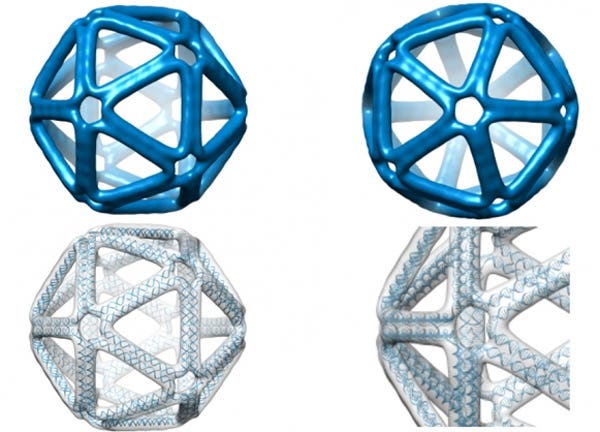Welcome to the World of Automated DNA Origami
June 3, 2016
U.S. researchers have created an algorithm that can build DNA nanoparticles automatically.
Chris Newmarker
|
The algorithm starts with a 3-D geometric representation of the final shape of the object, and then figures out how it can be assembled from DNA. (Image courtesy of MIT) |
A new algorithm could do away with the need to laboriously build complex DNA shapes by hand, according to the MIT-led research team that developed it.
The algorithm, called DAEDALUS (DNA Origami Sequence Design Algorithm for User-defined Structures), begins with a 3-D geometric representation of what its user would like the object's final shape to be--and then figures out how to assemble it using DNA, according to lead research Mark Bathe, an MIT biological engineering professor.
The algorithm, recently reported in the journal Science, could enable DNA origami to be used to create nanoparticles for many more applications than before, including vaccine scaffolds, gene editing tool carriers, and archival memory storage.
"Our hope is that this automation significantly broadens participation of others in the use of this powerful molecular design paradigm," Bathe said in an MIT news release. Researchers at Baylor College of Medicine and Arizona State University were also part of the team.
DAEDALUS starts out by representing an object as a smooth, continuous outline of its surface. The surface is then broken into a series of polygonal shapes.
The next step is to route a long, single strand of DNA like a piece of thread through the entire structure. The DNA strand, called the scaffold, holds the structure together.
DAEDALUS weaves the scaffold in a single, fast step. It can be used to create any type of 3-D shape, provided that the shape has a closed surface. Shapes with one or more holes are possible.
"That [step] is a powerful part of the algorithm, because it does not require any manual or human interface, and it is guaranteed to work for any 3-D object very efficiently," Bathe says.
A previous algorithm, published last year in the journal Nature, is only able to create spherical objects, and even then requires intervention by hand, MIT pointed out.
Bathe's collaborator, Wah Chiu at Baylor College of Medicine, validated the research team's strategy for creating the DNA nanoparticles, using a 3-D cryo-electron microscopy reconstructions.
The researchers' next step is to investigate applications for DNA nanoparticles created through DAEDALUS. For example, it could be used to create a scaffold for viral peptides and proteins for use as vaccines. They could also encapsulate the CRISPR-Cas9 gene editing tool--a significant need in the gene therapy space. DNA nanoparticles could also be used for sophisticated information storage.
The research team has shown that the DNA nanoparticles are stable for more than six hours in serum. They're seeking to increase the stability further.
DNA Origami from Biodesign Institute at ASU on Vimeo.
Chris Newmarker is senior editor of Qmed and MPMN. Follow him on Twitter at @newmarker.
Like what you're reading? Subscribe to our daily e-newsletter.
About the Author(s)
You May Also Like



